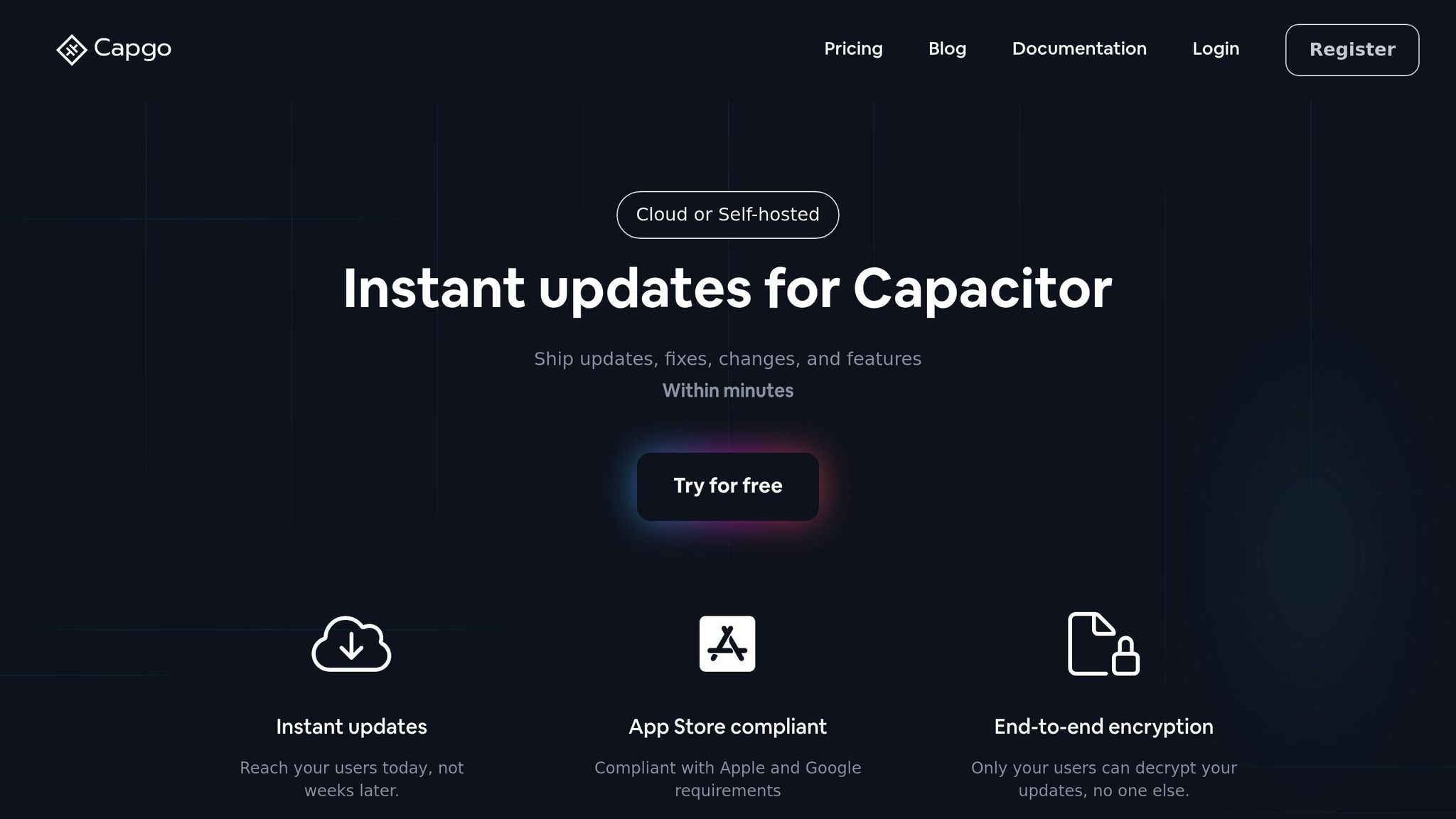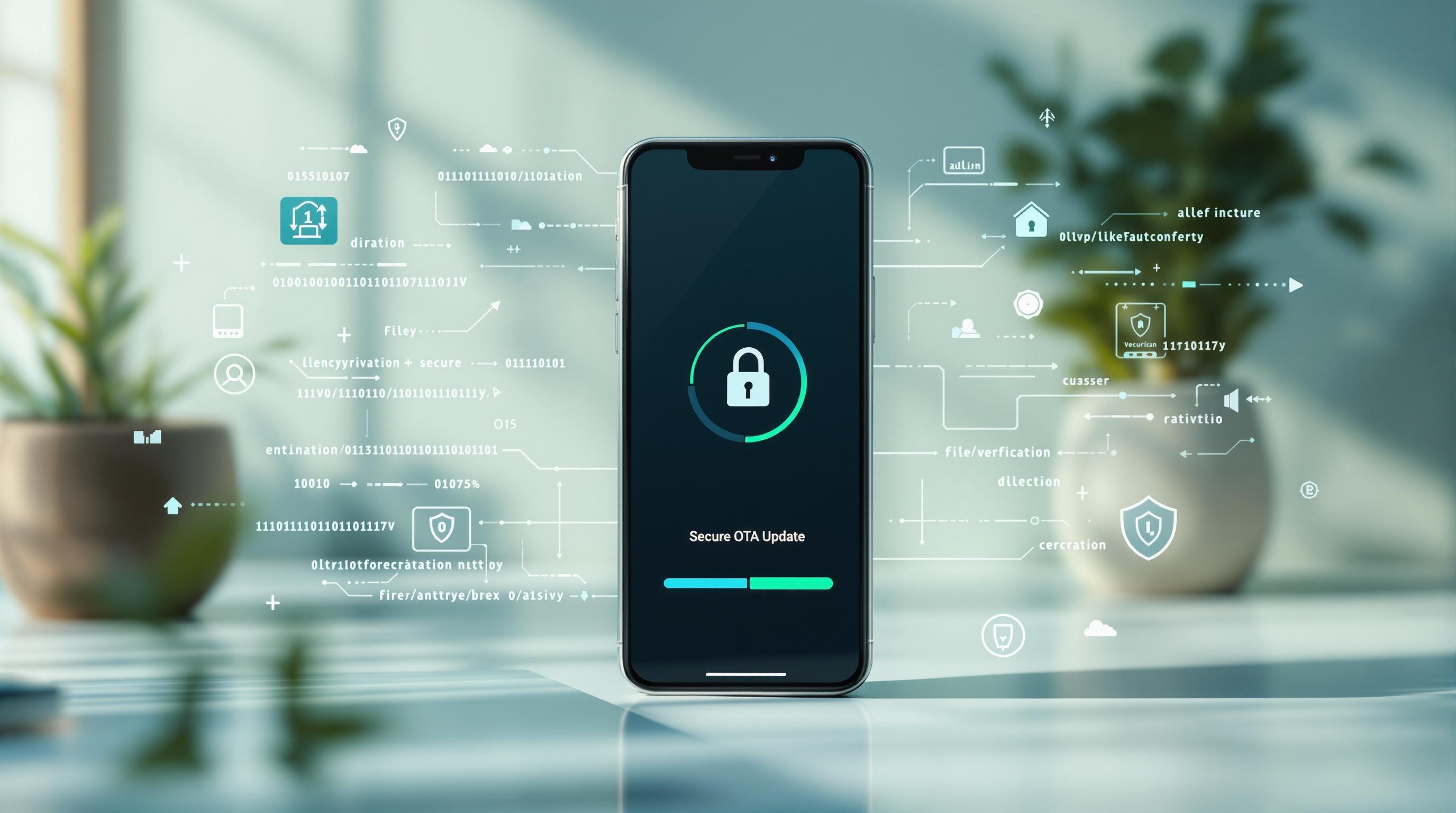Want secure OTA updates for your Capacitor app? Here’s the bottom line: OTA updates are fast and efficient but come with risks like data interception, file tampering, and server vulnerabilities. To keep your updates secure, focus on encryption, file verification, and access control.
Key Takeaways:
- Encrypt your updates: Use TLS 1.3 and end-to-end encryption to prevent interception.
- Verify files: Validate digital signatures and checksums to ensure update integrity.
- Control access: Use role-based permissions, device ID verification, and secure API keys.
Quick Comparison of OTA Platforms:
| Feature | Capgo | AppFlow | | --- | --- | --- | --- | | End-to-End Encryption | Yes | No | No | | Rollback Capability | Instant | Manual | Manual | | Update Success Rate | 82% worldwide | Limited data | Limited data |
Pro Tip: Capgo leads with 95% update adoption in 24 hours and advanced security features like real-time analytics and version control. Secure your OTA updates now by following these steps!
Capacitor 2.0: Mobile apps & PWAs from one codebase
Security Risks in OTA Updates
OTA updates can open the door to vulnerabilities that compromise both app security and user trust.
Risks of Data Interception
Man-in-the-middle attacks can intercept OTA update data, allowing unauthorized changes that could affect millions of users. To prevent this, end-to-end encryption is essential.
“The only solution with true end-to-end encryption, others just sign updates” [1]
Without proper encryption, intercepted files can be tampered with, leading to serious consequences.
File Tampering Threats
Tampered update files can introduce malicious code, disrupt app functionality, steal sensitive information, or introduce unauthorized features. This highlights the importance of strong file verification protocols to ensure updates remain secure and trustworthy.
Server Access Vulnerabilities
The table below outlines key server weaknesses and their potential impacts:
| Vulnerability | Impact |
|---|---|
| Weak Authentication | Unauthorized updates |
| Insufficient Role Management | Release of untested updates |
| Compromised API Keys | Distribution of malicious code |
These examples show why security must go beyond just signing updates. A layered approach - including encryption, verification, and strict access controls - is critical to protect the update process.
Security Steps for OTA Updates
To address potential risks, follow these targeted measures to secure OTA update delivery.
Data Encryption Methods
Using strong encryption methods is key to safeguarding OTA updates. End-to-end encryption ensures that update data stays protected during transmission and can only be accessed by authorized devices.
Here are the main components of a secure encryption setup:
| Component | Purpose | Implementation |
|---|---|---|
| TLS Protocol | Protects data during transmission | Use TLS 1.3 with strong cipher suites |
| End-to-End Encryption | Ensures only the intended recipient can decrypt data | Use verified end-to-end encryption protocols |
Update File Verification
Verifying update files ensures their integrity and authenticity. This process involves more than just signing the updates - it requires multiple layers of verification.
Steps to verify updates include:
- Digital signature validation: Use a public key infrastructure to confirm the authenticity of update package signatures.
- Checksum verification: Compare SHA-256 hashes to ensure the update file hasn’t been tampered with.
Additionally, enforce strict access controls to restrict update distribution to trusted entities.
Access Control Setup
Effective access controls are essential to prevent unauthorized distribution of updates. A secure system should include:
| Access Control Feature | Security Benefit |
|---|---|
| Device ID Verification | Confirms updates are sent to the correct devices |
| Role-Based Access | Manages who can deploy updates |
| API Key Management | Secures communication with update servers |
For larger deployments, granular permissions are crucial. They allow teams to assign specific rights for update deployment, control beta testing access, manage multiple organizations under separate permissions, and adjust roles as team needs change.
Combining encryption, verification, and strict access controls creates a secure framework for OTA updates during both development and deployment.
Testing and Release Steps
Thorough OTA testing is essential to identify vulnerabilities and ensure updates are stable.
Security Testing Steps
Before rolling out any updates, perform detailed security checks to ensure the updates are secure and compatible:
| Testing Phase | Key Actions | Security Focus |
|---|---|---|
| Pre-deployment | Verify update package signatures | Confirm update authenticity |
| Integration | Test encryption protocols | Ensure secure data transmission |
| System | Validate device compatibility | Check installation integrity |
| User acceptance | Conduct beta testing with select users | Validate security in practical use |
Encryption integrity should be checked throughout all testing phases to confirm that update packages remain secure during the process. Once the integrity of the updates is confirmed, have a plan in place to quickly reverse changes if any issues arise.
Update Rollback Options
Thorough testing supports reliable release strategies, including immediate rollback options and controlled staging. A well-designed rollback system can quickly address security issues after deployment.
Key components of an effective rollback system:
- Version Control System: Keep a complete history of all app versions, including security patches and feature updates.
- Automated Recovery: Use automated triggers for rollbacks, paired with clear recovery procedures.
“One-click rollback to any previous version if needed” [1]
Staged Release Process
Pair rollback strategies with a phased deployment plan to minimize risk and test security in real-time. A channel system helps control distribution and ensures updates are thoroughly tested before full deployment.
| Stage | Audience | Duration | Security Measures |
|---|---|---|---|
| Internal Testing | Development Team | 24–48 hours | Perform a full security audit |
| Beta Channel | Selected Users | 3–5 days | Monitor deployment closely |
| Production Roll-out | 10% of Users | 2–3 days | Track and resolve errors |
| Full Deployment | All Users | 1–2 weeks | Continuously monitor updates |
“Channel System: Advanced update distribution. Target specific user groups with different versions using channels for beta testing and staged rollouts” [1]
OTA Update Management Tools
Building on secure deployment and testing, strong OTA management tools are crucial for protecting your Capacitor updates.
Capgo Features Overview

Capgo provides advanced security for Capacitor OTA updates with end-to-end encryption, ensuring that only authorized users can decrypt the updates.
Here’s a breakdown of its key features:
| Feature | Security Benefit |
|---|---|
| End-to-End Encryption | Blocks unauthorized access to update content |
| Real-time Analytics | Tracks update delivery to ensure high completion rates |
| Version Control | Keeps a detailed update history for audits |
| CI/CD Integration | Streamlines secure deployment processes |
| Channel System | Manages update distribution by segmenting user groups |
Next, let’s see how major OTA platforms compare in terms of security and performance.
OTA Platform Comparison
When choosing an OTA platform for Capacitor apps, security and reliability are critical factors. Here’s how some of the top platforms measure up:
| Feature | Capgo | AppFlow | | --- | --- | --- | --- | | End-to-End Encryption | Yes | No | No | | Update Success Rate | 82% worldwide | Limited data | Limited data | | Rollback Capability | Instant | Manual | Manual | | Market Experience | Since 2022 | Shutting down 2026 | Since 2024 | | Update Distribution | Partial updates | Full bundle | Full bundle | | CI/CD Setup Cost | $2,600 one-time | Higher annual costs | Comparable |
“We practice agile development and @Capgo is mission-critical in delivering continuously to our users!” - Rodrigo Mantica [1]
Capgo’s performance metrics further emphasize its reliability:
- 750 production apps powered by Capgo
- 23.5 million updates successfully delivered
- 95% of active users complete updates within 24 hours [1]
These numbers showcase Capgo’s ability to deliver secure updates efficiently, making it an excellent choice for developers focused on both security and compliance with app store standards.
Post-Release Security Steps
Update Monitoring
Keeping an eye on your OTA updates in real time is key to ensuring security after deployment. Use your update management platform’s analytics dashboard to track important metrics like:
| Metric | Target Threshold | Security Implication |
|---|---|---|
| Update Success Rate | >82% worldwide | Shows strong update delivery |
| User Adoption Speed | 95% within 24 hours | Indicates effective user engagement |
Automate alerts to catch unusual activity in update performance. This helps you identify and address issues quickly. With real-time monitoring, you can keep your system secure while staying ahead of potential problems.
Security Maintenance
Regularly review server logs and authentication systems to spot potential security threats early. Daily monitoring can uncover issues before they escalate - Capgo analytics back this up with data [1]. Also, make it a habit to check critical security components like SSL certificates, API authentication tokens, and access controls. This ensures your encryption and authentication setups stay up-to-date.
User Security Guide
Help users stay secure by encouraging them to accept updates promptly. Clear communication is essential - keep users informed and address their concerns through feedback channels.
“Track update success rates and user engagement in real-time” - Capgo [1]
Summary
Effective OTA security relies on encryption, file verification, and consistent monitoring. When implemented correctly, these strategies lead to impressive update success rates [1].
End-to-end encryption plays a critical role in protecting OTA updates, blocking unauthorized access and tampering. For example, Capgo achieves a 95% update rate among active users within 24 hours, highlighting the importance of strong encryption [1]. These elements form the backbone of a secure and reliable OTA update system.
| Security Component | Key Implementation | Benefit |
|---|---|---|
| Encryption | End-to-end protection | Blocks unauthorized access |
| Verification | File integrity checks | Confirms update legitimacy |
| Monitoring | Real-time analytics | Detects issues quickly |
| Access Control | Role-based permissions | Restricts unauthorized changes |
“We practice agile development and @Capgo is mission-critical in delivering continuously to our users!” - Rodrigo Mantica [1]
Maintaining security requires continuous attention and the right tools. With proper monitoring, quick responses to threats, and regularly updated protocols, your OTA system can remain both secure and efficient. This aligns with thorough testing, careful management, and well-planned post-release processes.




